Savate: French Kickboxing and Its Unique Style
Savate and Boxe Française
Savate, also known as French boxing or Boxe Française, is a style of French kickboxing. Originating in France during the 19th century, savate was learned by sailors on their trips to the Indian Ocean and the China Sea. These French sailors learned these techniques on their expeditions and shaped them into a martial art that quickly became famous in Parisian society. In this post, we’ll uncover savate, giving you its unique history and list of techniques.
The Philosophy and Values of Savate

Savate prides itself on being aesthetic yet ethical—a martial art that is intended to look great while being able to maintain proper rules and etiquette. Students of savate are also encouraged to constantly develop their physical and mental capabilities. However, savate is not particularly a traditional martial art, meaning it does not have a philosophy based on Buddhist or Zen principles like some Japanese or Chinese martial arts.
Savate is characterized by the use of shoes during fights, with the French word “savate” meaning “old shoe” or boot. French sailors and street fighters used footwear like this, kicking with their heavy boots as a form of self-defense.
History of Savate
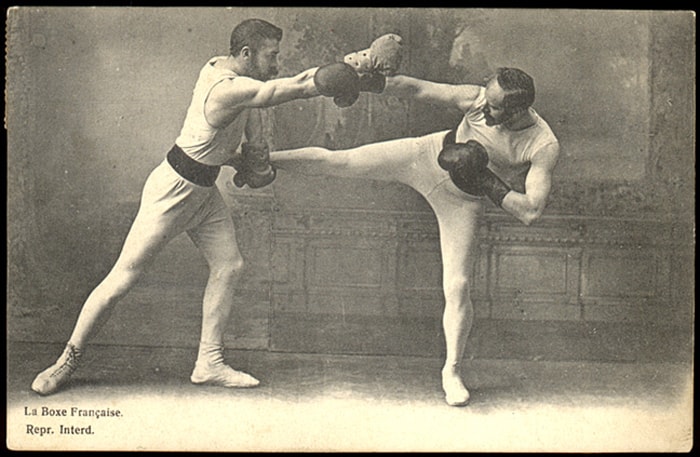
The history of Savate and Boxe Française dates back to early 19th-century France, where they were developed in port cities like Marseille. Below is a breakdown of its history:
- Origins and Development: Savate began as a street-fighting technique used by sailors and dockworkers in Marseille. It was a method of self-defense that involved kicking with heavy shoes or boots as well as open-hand strikes like slaps. Savate was developed in such a way that sailors were able to fight better on the swaying deck of a ship. French sailors believed kicks and slaps were a better way of balancing strikes on a moving ship.
- Formalization: Michel Casseux, also known as “Le Pisseux,” was a pioneer of savate and is often credited as being the inventor of the martial art. In the early 1800s, he began to formalize the techniques of savate, and he opened the first savate school in 1825. This helped transform savate from a street-fighting method into a recognized martial art.
- Integration with Boxing: Charles Lecour was one of the best students of Michel Casseux. He introduced English boxing techniques to Savate after observing a bout between an English boxer and a French Savateur. This integration led to the development of “La Boxe Française,” combining punches from boxing with the kicks of savate. The blend of the two martial arts developed the new style known as French boxing, or savate.
- Military Influence: Savate gained popularity and was adopted by the French military. It became part of the training regimen for soldiers. It was recognized for its practicality in real-world scenarios and was even used by foreign militaries.
- Sport and Competition: By the late 19th and early 20th centuries, savate had evolved further into a competitive sport. Organized matches and standardized rules were created, and the sport spread internationally, becoming very popular in Europe.
- Modern Era: Today, savate is still practiced worldwide and is recognized for its elegance, efficiency, and technical precision. It remains a competitive sport with different levels of contact, from light contact (assaut) to full contact (combat).
The history of Savate boxe francaise is vast, and compared to some modern kickboxing styles, it has a deeper background, especially as it was practiced during the 19th century.
Savate Techniques and Training
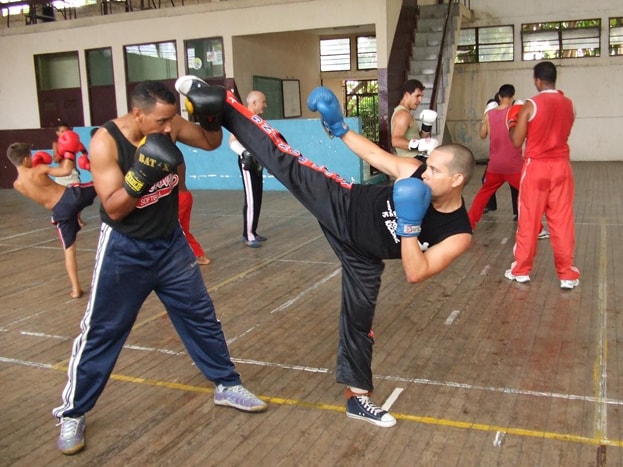
Punches and Kicks
Savate combines elements of western boxing with efficient yet elegant kicking techniques. The sport combines the techniques of Savate kicks with the punching style of English boxing, meaning that it uses both punches and kicks in combinations. Savate kicking techniques use the boot effectively, with some kicks using the heel, toe, blade, or side of the shoe. Below are some of the most commonly used techniques in savate.
Kicking Techniques
- Fouetté (Whip Kick): A roundhouse kick using the instep.
- Chassé (Push Kick): A thrusting kick using the heel.
- Revers (Reverse Kick): A kick using the sole or heel, typically aimed at the opponent’s face or body.
- Coup de pied bas (Low Kick): A sweeping kick aimed at the opponent’s legs.
- Coup de pied médian (Mid-level Kick): A kick aimed at the opponent’s midsection.
- Coup de pied haut (High Kick): A kick aimed at the opponent’s head or upper body.
- Balayage (Sweep): A technique to unbalance or take down an opponent by sweeping their legs.
Punching Techniques
- Direct (Straight Punch): A straight punch similar to a jab in boxing.
- Crochet (Hook): A punch delivered in a circular motion.
- Uppercut (Uppercut): An upward punch typically aimed at the opponent’s chin.
- Swing (Swing): A wide, arcing punch.
Defensive Techniques
- Parade (Parry): A technique to deflect or redirect an opponent’s attack.
- Esquive (Evasion): A technique to dodge or avoid an attack.
- Blocage (Block): Using the forearm or shin to block an opponent’s strike.
- Dérobement (Slip): A quick, subtle movement to avoid an attack without stepping away.
Footwork
- Pas de retrait (Step Back): Stepping backward to evade an attack.
- Pas de côté (Side Step): Moving to the side to avoid an attack or to change angles.
- Pas de replacement (Replacement Step): Quickly stepping in and out to adjust distance.
The Two Types of Savate
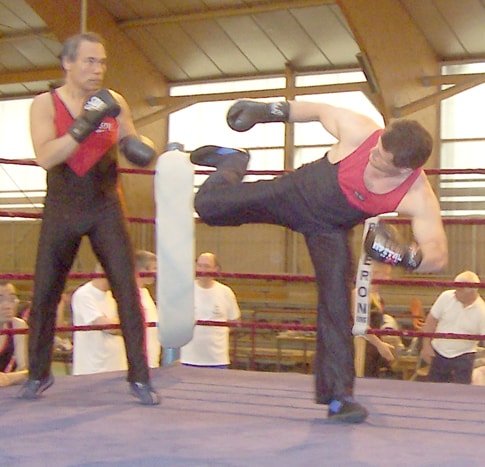
Assault Savate and Combat Savate are two competitive formats within the martial art of Savate. Assault Savate focuses on controlled, technical execution of techniques where the aim is to score points through clean, precise strikes while avoiding excessive force. Judges evaluate the skill, accuracy, and form of each technique. This means Assault Savate is a safe way of learning and competing in the martial art without getting injured.
Combat Savate, on the other hand, involves full-contact engagement in the savate competition, where power and effectiveness are critical. Competitors in Combat Savate aim to dominate their opponents using both striking and defensive techniques. Matches are judged on both the damage inflicted and the technical skill displayed. Both formats maintain the core principles of savate, including discipline, respect, and strategic use of kicks and punches, but they differ in their intensity and intentions.
Benefits of Savate Training
Savate is a comprehensive martial art that includes a variety of physical conditioning techniques. Training in Savate is usually quite intense and can be a great way to improve fitness, mental health, agility, and flexibility. It also offers a fun, full-body workout and a strategic challenge. Most of all, Savate is an accessible martial art to get started in, as it is beginner-friendly.
French Boxing Compares to Other Martial Arts
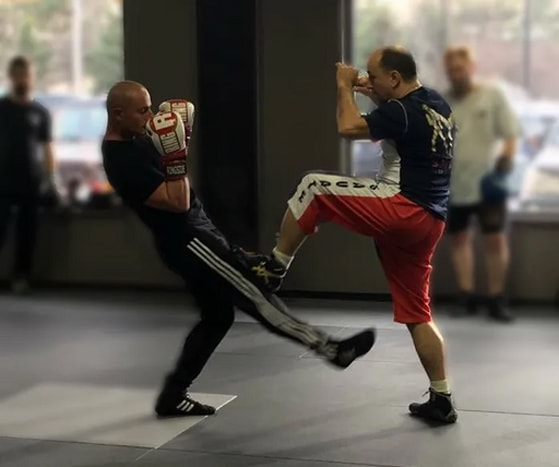
There are many martial arts that resemble kickboxing or are styles of kickboxing. These include Thai boxing (Muay Thai), Dutch kickboxing, Sanda, and Kyokushin Karate. All of these styles come with their own unique techniques and philosophies; however, when we compare the techniques of these martial arts, there are some similarities. The main similarity is that they all contain punching and kicking techniques.
The main differences are in the ruleset and how the martial arts are practiced. For example, Thai boxing is practiced as a highly competitive sport and is intended to be contested in a ring for entertainment purposes, whereas Kyokushin karate is practiced both as a competitive martial art and as a form of self-defense. While some of the techniques can be similar, the intentions are different. For example, savate kicks are less powerful than Thai boxing kicks, as the intentions in savate are to score points and the intentions in Thai boxing are to win by knockout.
The ruleset of Muay Thai is more relaxed, meaning elbows, knees, and clinching are all permitted. The French kickboxing style of savate doesn’t allow those techniques and is usually not practiced as a sport but instead as a competitive martial art. This means savate practitioners are not looking to become world-famous prize fighters.
Savate is a traditional French martial art, but it is also a competitive fighting style. It is a distinct martial art with its own history and governing body, the International Savate Federation (FIS). This means that it fares very well compared to other martial arts and kickboxing styles.
Practice of Modern Savate
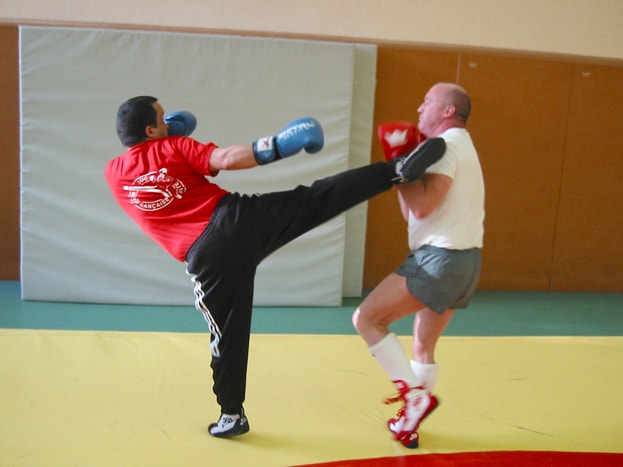
Savate is accessible worldwide, with numerous gyms and clubs offering classes for all skill levels. These facilities often participate in local and international competitions, making it relatively easy for new students to find training opportunities. Although it is practiced worldwide, it will be easier to find savate academies within France or in large capital cities across the world. This is because bigger cities usually host a variety of martial arts clubs.
Many countries have national federations focused on promoting savate, such as the United States Savate Federation (USSF), which is the official governing body of savate in the United States.
Cultural Elements of Savate
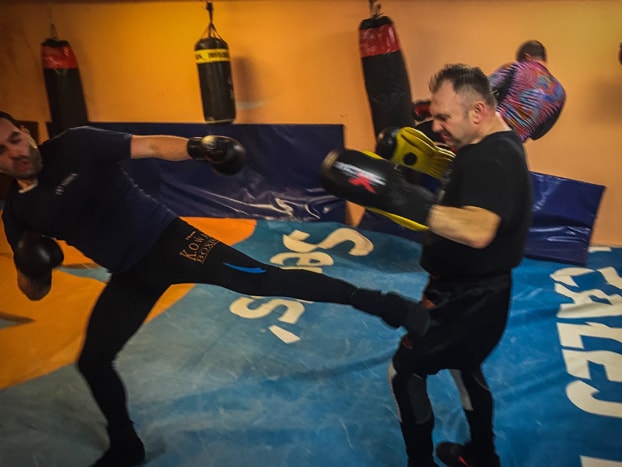
Savate has been referenced in various forms of media, including TV shows, movies, and video games. Bruce Lee also studied savate, and it is believed that he included some of the techniques in his own martial arts style of Jeet Kune Do. While it has had a presence in movies and TV series, its most important cultural value is in France, where savate has clearly had an undeniable impact.
Summary
Savate is a martial art that has a unique cultural heritage linked to French maritime history. However, from this interesting maritime story, Savate has grown into a sport and a well-versed martial art that is now practiced globally. Savate is a martial art that is elegant, culturally important, and, above all, highly effective in many scenarios.
Frequently asked questions
What’s the difference between kickboxing and Savate?
The main difference between kickboxing and Savate is the fluidity of combinations. Some styles, such as Dutch kickboxing, have faster and more aggressive combinations, while Savate places more emphasis on perfecting techniques and elegancy.
How do you win in Savate?
Points are awarded based on the precision, technique, and impact of the strike. Scoring points also depend on the amount of ring control or ring dominance.
Does Savate have knees?
Traditional savate does not use knees; however, there might be some styles of modern savate that practice with knee strikes.
Does Savate have grappling?
No, Savate does not include grappling within its techniques.
What is Savate in French?
Savate in French will usually go by the names Boxe Francaise Savate or Savate Boxe Française.









